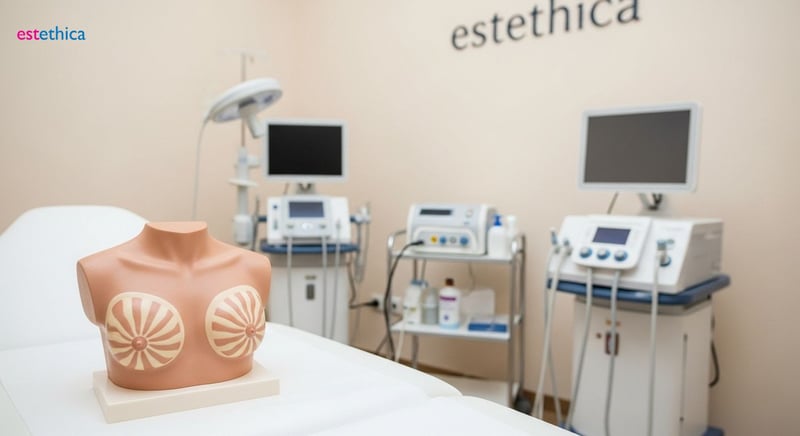Gynecomastia: Beyond 'Man Boobs' - Understanding Male Breast Reduction
Gynecomastia, often associated with 'man boobs', requires specialized treatment for effective management. Discover options with estethica today.
Gynecomastia is a condition that affects a significant number of men worldwide. Characterized by enlarged male breasts, it can lead to various emotional and psychological challenges. This comprehensive guide explores the condition, its impact, treatment options, and recovery expectations.
Decoding Gynecomastia: What It Is And What It Isn't
Distinguishing True Gynecomastia From Pseudogynecomastia
It's essential to differentiate between true gynecomastia and pseudogynecomastia for accurate diagnosis and treatment planning. True gynecomastia involves the enlargement of glandular breast tissue, driven by hormonal imbalances, often an increase in estrogen relative to testosterone. Pseudogynecomastia, on the other hand, presents as fat accumulation in the chest area without the glandular proliferation seen in true gynecomastia, frequently associated with overall weight gain and obesity. Therefore, individuals experiencing enlarged male breasts should seek professional evaluation to determine the underlying cause.
The first step in determining the appropriate intervention will be a thorough medical examination that could include blood work to assess hormonal levels. In some cases, imaging studies like mammograms or ultrasounds may be necessary to visualize breast tissue composition. Once correctly diagnosed, individuals can investigate effective treatment options. For example, in true gynecomastia, hormonal therapies may be considered initially, whereas lifestyle changes and weight management might be the first line of approach for pseudogynecomastia. Gynecomastia surgery, which addresses gynecomastia, is also an option to be considered. In 2024, roughly 40% of men seeking male breast reduction were initially misdiagnosed, highlighting the need for precise evaluation and diagnosis, that is achievable thanks to Esthetica Global specialist doctors.
Effective Management Approaches for Gynecomastia and Pseudogynecomastia
Managing gynecomastia and pseudogynecomastia requires tailored strategies that address the specific underlying causes. For true gynecomastia, a multidisciplinary approach may involve endocrinologists to manage hormonal imbalances and surgeons, such as those at Esthetica Global, to remove excess glandular tissue if medical treatments are ineffective. Conditions causing hormonal imbalances include medication side effects, certain medical conditions, or even natural hormonal fluctuations during puberty or aging.
On the other hand, pseudogynecomastia management primarily focuses on lifestyle modifications. Regular exercise and a balanced diet can significantly reduce overall body fat, including chest fat. Strength training can improve muscle tone in the chest area, producing a more contoured appearance. For those who are not satisfied with these changes, cosmetic procedures like liposuction can be used to remove localized fat deposits. This approach is particularly effective for individuals who have lost weight but still have residual chest fat. Here are key measures for accurately diagnosing and managing each condition effectively to achieve the best physical and psychological outcomes:
- Hormonal Assessment: A thorough evaluation of hormone levels to identify true gynecomastia.
- Lifestyle Adjustments: Focus on diet and exercise to manage pseudogynecomastia.
- Expert Consultation: Seeking guidance from specialists at Esthetica Global for tailored treatment plans.
Here are common causes to consider:
- Medication Side Effects: Certain drugs can disrupt hormonal balance, leading to gynecomastia.
- Obesity: Excess body fat increases estrogen production, exacerbating pseudogynecomastia.
- Underlying Medical Conditions: Conditions affecting hormone production can contribute to gynecomastia.

The Emotional Impact of Enlarged Male Breasts: Why Address Gynecomastia?
The Psychological Burden of Gynecomastia on Men
Gynecomastia can profoundly affect a man's emotional state, leading to feelings of inadequacy and self-consciousness. The physical changes associated with enlarged male breasts often result in significant psychological distress, triggering a range of emotional responses. Men may experience heightened anxiety about their physical appearance, leading them to avoid social situations where their condition might be noticed. This self-imposed isolation can further exacerbate feelings of loneliness and depression, impacting overall quality of life.
Addressing gynecomastia through effective treatment options, such as those offered at Esthetica Global, is not merely a cosmetic consideration but a vital step toward restoring emotional well-being. For instance, the inability to participate in activities like swimming or changing in public locker rooms due to self-consciousness can create barriers to social interaction and physical health. Restoring a more masculine chest contour through surgical intervention often leads to a renewed sense of confidence and improved self-esteem, allowing men to engage more freely in various aspects of life.
Strategies for Overcoming Emotional Challenges Related to Gynecomastia
Dealing with the emotional challenges of gynecomastia requires a multifaceted approach that addresses both the physical and psychological aspects of the condition. Seeking support from mental health professionals who specialize in body image issues can provide coping strategies and therapeutic interventions that help men navigate their feelings of embarrassment or anxiety. Cognitive-behavioral therapy (CBT), for example, can help individuals challenge negative thought patterns and develop a more positive self-image.
In addition to professional support, adopting lifestyle changes can also play a crucial role in improving mental health. Regular exercise not only helps to reduce body fat but also releases endorphins, which have mood-boosting effects. Connecting with support groups or online forums where men share their experiences with gynecomastia can also provide a sense of community and reduce feelings of isolation. Here are some practical steps to consider:
- Seek Professional Counseling: Engage with therapists experienced in body image and self-esteem issues to develop coping mechanisms.
- Engage in Physical Activity: Incorporate regular exercise into your routine to boost mood and improve physical health.
- Join Support Networks: Connect with others who have experienced gynecomastia to share experiences and gain support.
Here are some strategies for those seeking treatment options:
- Medical Evaluation: Consult with specialists at Esthetica Global for a comprehensive assessment and personalized treatment plan.
- Surgical Intervention: Consider male breast reduction surgery to remove excess tissue and restore a masculine chest contour.
- Post-Operative Support: Engage in aftercare programs to ensure optimal recovery and long-term satisfaction with results.

Navigating Gynecomastia Treatment Options: Surgical and Non-Surgical Approaches
Surgical Interventions for Gynecomastia: A Permanent Solution
For men seeking a definitive solution to gynecomastia, surgical options offer a permanent way to remove excess glandular tissue and fat. Liposuction is frequently used to address excess fat, particularly in cases of pseudogynecomastia, where the primary concern is fat accumulation rather than glandular enlargement. Gland excision, on the other hand, involves the surgical removal of the enlarged glandular tissue and is typically recommended for true gynecomastia cases. Consultation with surgeons at estethica is crucial to determine the most appropriate surgical technique based on individual anatomy and condition severity.
Surgical approaches have improved considerably, with minimally invasive techniques now available that reduce scarring and recovery time. These methods often use smaller incisions, resulting in less post-operative discomfort and a quicker return to normal activities. The effectiveness of surgery is closely tied to the surgeon's expertise and the precision with which the procedure is performed. Many patients report significantly improved body image and self-esteem following surgical correction of gynecomastia. Therefore, selecting a skilled and experienced surgical team like the one at Esthetica Global is important.
Non-Surgical Approaches to Managing Gynecomastia
While surgical interventions offer permanent solutions, non-surgical methods can effectively manage certain types of gynecomastia, particularly pseudogynecomastia. Weight loss, achieved through a combination of diet and exercise, is frequently recommended as a first-line treatment for reducing chest fat. Hormone therapy, targeting hormonal imbalances, may be considered in cases where hormone levels contribute to glandular enlargement to reduce enlarged male breasts.
Lifestyle changes also play a crucial role, including avoiding certain medications or substances that can exacerbate gynecomastia. Anabolic steroids, for example, are known to disrupt hormonal balance and induce breast enlargement in men. Consulting with a specialist at clinics such as estethica to determine the most appropriate action is essential. Below are potential pathways worth investigating.
- Weight Management Programs: Structured diet and exercise plans help reduce overall body fat, including chest fat.
- Hormone Monitoring: Regular check-ups to adjust hormone therapy based on individual responses.
- Medication Review: Evaluation of current medications to identify and replace those contributing to the condition.
The details of non-surgical methods should incorporate the following elements.
- Dietary Adjustments: Reduce intake of processed foods and increase consumption of lean proteins and vegetables.
- Exercise Regimen: Incorporate both cardiovascular and strength training exercises to burn fat and build muscle.
- Substance Evaluation: Identify and eliminate substances that disrupt hormone balance from daily routines.

Male Breast Reduction Recovery: Expectations and Aftercare for Optimal Results
Understanding Post-Surgical Care After Gynecomastia Treatment
Post-surgery recovery is a fundamental phase in achieving the desired results from male breast reduction. Patients can anticipate some degree of discomfort and swelling, which can effectively be managed with prescribed medications. It's imperative for patients to adhere to the specific aftercare instructions provided by their healthcare provider to ensure adequate healing and to minimize the risk of complications. At Esthetica Global, detailed post-operative guidelines are provided to each patient, which often include wearing compression garments, avoiding strenuous activities, and attending follow-up appointments. For example, most patients are advised to wear a compression vest for several weeks to help reduce swelling and support the chest contours as they heal.
Adherence to these guidelines not only facilitates healing but also helps in achieving the best possible cosmetic outcome. Regular check-ups with the surgical team at Esthetica Global helps monitor recovery progress and address any concerns promptly. Moreover, it is highly recommended for patients to maintain a healthy lifestyle, including a balanced diet and gentle exercise, which supports overall healing and helps to maintain the results of the surgical procedure.
Essential Aftercare Tips for Optimal Healing
Following male breast reduction, certain precautions and practices can significantly impact the recovery process and the final aesthetic result. Wearing compression garments as prescribed by the surgeon is vital. These garments help to minimize swelling, support the tissues as they heal, and promote proper skin retraction. Patients should also avoid activities that could strain the chest area, such as heavy lifting or vigorous exercise, for a specified period. Esthetica Global's post-operative care includes detailed instructions on wound care, medication management, and activity restrictions to ensure the patient recovers smoothly and effectively.
A balanced diet rich in protein and vitamins supports tissue repair and reduces the risk of infection. Staying hydrated is also essential for overall health and recovery. Additionally, patients should protect the treated area from direct sunlight to prevent hyperpigmentation of the scars. Here are some essential components for the aftercare protocol:
- Consistent garment use: Helps reduce swelling and support chest contour as it heals
- Adequate Hydration: Supports overall health and helps in the recovery process.
- Wound Care: Following surgeons post-operative wound care, patients reduce the risk of infection.
Additionally, here is a list of steps to consider during recovery:
- Follow Medication instructions: Medications prevent infection, helps with pain and inflammation.
- Keep Follow-up Appointments: Appointments with Esthetica Globals' surgical team ensure the best outcome and monitors progress.
- Protect from Direct Sunlight: Prevents any hyperpigmentation of scars.
Understanding Gynecomastia: Causes, Symptoms, and Treatments
Minimally Invasive Gynecomastia Surgery Expertise at estethica Results in Reduced Scarring
estethica's Comprehensive Aftercare Protocol for Male Breast Reduction Ensures Best Possible Recovery
Frequently Asked Questions
What is gynecomastia and how does it differ from pseudogynecomastia?
What are some non-surgical options for managing enlarged male breasts?
What can I expect during the recovery period following male breast reduction surgery?
How does gynecomastia affect men emotionally, and what support is available?
Achieve your aesthetic goals with estethica's personalized treatment plans and expert care.
📞 Schedule Your Free Consultation!